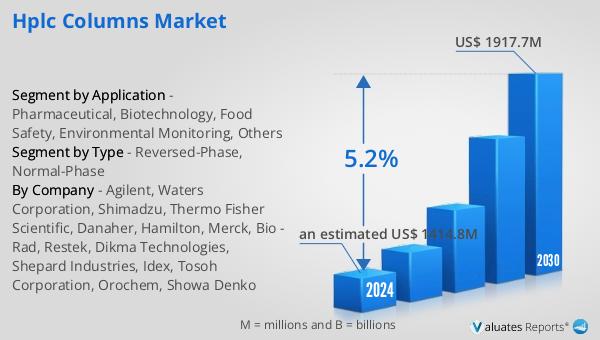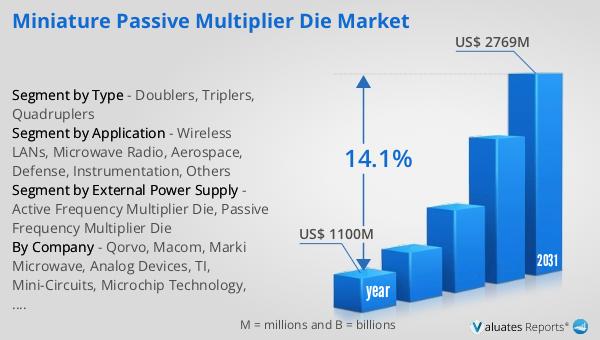What is Global HPLC Columns Market?
The global HPLC Columns market is a specialized segment within the broader chromatography market, focusing on High-Performance Liquid Chromatography (HPLC) columns. These columns are essential components in HPLC systems, which are widely used for separating, identifying, and quantifying compounds in various mixtures. The market encompasses a variety of column types, including reversed-phase, normal-phase, ion-exchange, and size-exclusion columns, each designed for specific applications and separation needs. The demand for HPLC columns is driven by their critical role in research and development, quality control, and regulatory compliance across multiple industries such as pharmaceuticals, biotechnology, food and beverage, environmental monitoring, and more. The market is characterized by continuous innovation, with manufacturers striving to develop columns that offer higher efficiency, better resolution, and faster analysis times. As industries increasingly rely on precise and reliable analytical techniques, the global HPLC Columns market is poised for sustained growth, reflecting its indispensable role in modern analytical science.

Reversed-Phase, Normal-Phase in the Global HPLC Columns Market:
Reversed-phase and normal-phase chromatography are two fundamental techniques used in the global HPLC Columns market, each with distinct characteristics and applications. Reversed-phase chromatography is the most widely used technique, characterized by a non-polar stationary phase and a polar mobile phase. This method is particularly effective for separating compounds based on their hydrophobic interactions. It is commonly used in the pharmaceutical industry for drug development and quality control, as it can efficiently separate and analyze a wide range of compounds, including small molecules, peptides, and proteins. The versatility and robustness of reversed-phase chromatography make it a preferred choice for many analytical laboratories. On the other hand, normal-phase chromatography employs a polar stationary phase and a non-polar mobile phase. This technique is ideal for separating compounds based on their polarity and is often used for the analysis of lipids, fatty acids, and other non-polar substances. Normal-phase chromatography is particularly useful in the food and beverage industry for quality control and safety testing, as it can effectively separate and identify various contaminants and additives. Both reversed-phase and normal-phase chromatography play crucial roles in environmental monitoring, where they are used to detect and quantify pollutants and other hazardous substances in water, soil, and air samples. The choice between reversed-phase and normal-phase chromatography depends on the specific analytical requirements, including the nature of the compounds being analyzed and the desired separation efficiency. As the global HPLC Columns market continues to evolve, advancements in column technology and the development of new stationary phases are expected to enhance the performance and applicability of both reversed-phase and normal-phase chromatography. These innovations will further expand the range of applications and improve the accuracy and reliability of analytical results, driving the growth and diversification of the HPLC Columns market.
Pharmaceutical, Biotechnology, Food Safety, Environmental Monitoring, Others in the Global HPLC Columns Market:
The global HPLC Columns market finds extensive usage across various sectors, including pharmaceuticals, biotechnology, food safety, environmental monitoring, and others. In the pharmaceutical industry, HPLC columns are indispensable for drug development, quality control, and regulatory compliance. They are used to separate and analyze active pharmaceutical ingredients (APIs), impurities, and degradation products, ensuring the safety and efficacy of medications. The precision and reliability of HPLC columns make them a critical tool in the pharmaceutical sector, where stringent quality standards must be met. In biotechnology, HPLC columns are used for the analysis of biomolecules such as proteins, peptides, nucleic acids, and metabolites. They play a vital role in research and development, helping scientists understand complex biological processes and develop new therapies and diagnostics. The ability to accurately separate and quantify biomolecules is essential for advancing biotechnological innovations. Food safety is another significant application area for HPLC columns. They are used to detect and quantify contaminants, additives, and residues in food and beverage products, ensuring compliance with safety regulations and protecting public health. HPLC columns enable the precise analysis of a wide range of substances, from pesticides and mycotoxins to artificial sweeteners and preservatives. Environmental monitoring relies on HPLC columns to detect and measure pollutants and hazardous substances in various environmental samples, including water, soil, and air. This application is crucial for assessing environmental quality, identifying pollution sources, and implementing effective remediation strategies. HPLC columns provide the sensitivity and accuracy needed to monitor trace levels of contaminants and ensure environmental protection. Other application areas for HPLC columns include clinical diagnostics, forensic science, and chemical research. In clinical diagnostics, HPLC columns are used to analyze biological samples for disease markers, therapeutic drug monitoring, and metabolic profiling. Forensic scientists use HPLC columns to analyze evidence samples, such as drugs, toxins, and biological fluids, aiding in criminal investigations and legal proceedings. In chemical research, HPLC columns are employed to study the properties and behaviors of various chemical compounds, contributing to the advancement of scientific knowledge. The versatility and precision of HPLC columns make them an essential tool across these diverse fields, driving their widespread adoption and continuous innovation in the global market.
Global HPLC Columns Market Outlook:
The global HPLC Columns market is projected to reach US$ 1917.7 million by 2030 from an estimated US$ 1414.8 million in 2024 at a CAGR of 5.2% during 2024 and 2030. The top three companies hold a share about 42%. North America is the largest production area has a share about 56% followed by Europe and Japan with share 20% and 13% separately. The largest market is North America holds a share about 43% followed by Europe and AsiaPacific with around 29% and 22% market share respectively.
| Report Metric | Details |
| Report Name | HPLC Columns Market |
| Accounted market size in 2024 | an estimated US$ 1414.8 million |
| Forecasted market size in 2030 | US$ 1917.7 million |
| CAGR | 5.2% |
| Base Year | 2024 |
| Forecasted years | 2024 - 2030 |
| Segment by Type |
|
| Segment by Application |
|
| By Region |
|
| By Company | Agilent, Waters Corporation, Shimadzu, Thermo Fisher Scientific, Danaher, Hamilton, Merck, Bio - Rad, Restek, Dikma Technologies, Shepard Industries, Idex, Tosoh Corporation, Orochem, Showa Denko |
| Forecast units | USD million in value |
| Report coverage | Revenue and volume forecast, company share, competitive landscape, growth factors and trends |
